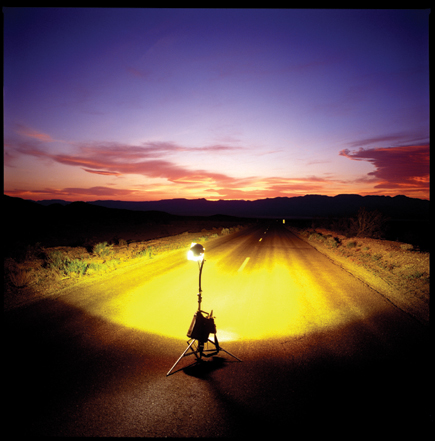Hide In Plain Sight ; Chip Simons’ Light Strategy
If you've glanced at the photos and you're not laughing, you might
think about skipping ahead to the next story. On these pages we're going
to spend some time in the bemusement park that's the mind of Chip Simons,
and if the weird light he's shining into the darkness didn't bring
at least a smile, you're probably not going to enjoy the visit.
Chances are you've encountered Chip before but might not have been aware
that what you were seeing belonged to him. His photographs are marked by the
use of fisheye or ultra-wide-angle lenses and a rainbow of color gels, and for
over 20 years they've appeared in numerous national publications, including
Newsweek, People, The New York Times Magazine, Esquire, Forbes, and Rolling
Stone, and in advertisements for, among others, Hertz, Apple, and American Express.
He is the creator of the I Am a Dog series of low-angle, fisheye views of curious
canines bathed in red, blue, or green light.
 |
|
|
Don't be fooled. Chip is offbeat, not random, and behind everything
there's an imaginative and pragmatic intelligence. The fisheye images
did not begin as a deliberate effort to achieve the strange through distortion.
Chip simply wanted his foreground and background subjects to be rendered sharp,
and his search for ever-greater depth of field led him to wider and wider lenses
until he arrived at the fish. The color gels are used to convey emotion. Sometimes
it's the emotion he attributes to the people in his photos; other times--as
in the dog series--it's meant to work against type, so you get cuddly
poodles in angry red light and menacing German shepherds in friendly baby-blue
tones.
And then there are times when his images are different because he doesn't
want to be bored by shooting the way everyone else does. He once said, "When
a popular magazine does a story on Charles Manson, they do his hair and makeup
and put him in Gap clothes. I think you should light the guy with a light bulb.
The world isn't a bunch of people in soft light."
 |
If you know the work but not the name, you're not alone. Many young
art directors, account executives, and magazine editors see his photographs
and remark favorably on how much he's like that guy with the wide-angle
lenses and the color gels. Chip has said that there've been times that
he's been hired to copy the style of "the weird dog guy."
The photos here are from what Chip calls "the probe series," and,
once again, they aren't the result of a search for the weird or the unusual.
Rather, they began as the solution to a problem. Of course, when you're
Chip Simons, you turn the solution into an image series.
The probes began 10 years ago outside Laughlin, Nevada. "I wanted to photograph
the casino sign behind the water tank," Chip says. "I use wide-angle
lenses all the time and it's really hard to get light stands out of the
pictures. In Laughlin I knew there was no way I could get f/11 on a water tank
that was probably 35 feet in diameter, so I put the light up there and thought,
what the hell, it kind of fits in with the fencing, so I'll just leave
it in the photo and [the client] can take it out if he wants to. I took the
picture thinking that it was so funny to actually see the light stand.
 |
"Then I drove away, and I'm on the highway when I thought, I'll
photograph my light stand again. Let me see how far 1200 watts of yellow can
go if I shoot wide-open. Well, it went way the hell down there--it's
the one where you see the yellow light on the highway."
So while most photographers go through contortions to disguise the fact that
lights were used, and "Light Shall Not Call Attention Unto Itself in a
Photograph" was the sixth commandment chiseled on photography's
stone tablets, Chip figuratively said, "Let there be light in the photo,"
and he continued off and on for some 10 years to place his light stand in "interesting
and unlikely places."
































